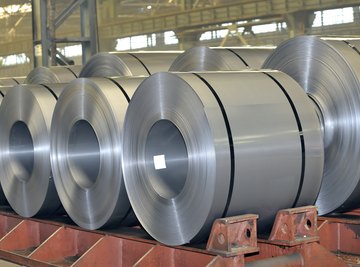
Hot rolling and cold rolling are two methods of shaping steel. During the hot-rolling process, steel is heated to its melting point while being worked, changing the composition of the steel to make it more malleable. During cold rolling, the steel is annealed, or exposed to heat and allowed to cool, which improves ductility. The steel is then shaped at room temperature, greatly increasing the hardness of the finished product.
Rough Treatment
During hot rolling, steel is heated to just beneath its melting point and then repeatedly subjected to rolling, making it thinner and longer. This process reconfigures the crystalline structure of the steel, making it much softer and more malleable. Once the steel has been rolled, it's subjected to a descaling process that removes oxidized iron from the surface of the steel. Then a roughing process heats the steel one last time for finished rolling. The steel can reach temperatures of up to 2,100 degrees Fahrenheit during the roughing process. Finally the steel is descaled again and finished to the thickness of the final product.
Hot Enough to Handle
Hot-rolled steel is malleable and perfect for industrial applications such as structural beams, rail tracks and sheet metal. Hot-rolled steel has a blue-gray appearance and a rough feel once it completes the rolling process and will remain malleable and soft. Because the steel retains its ductility, it can be molded into very precise or distinct shapes. Hot rolling is also the preferred process for larger steel shapes as compared to cold rolling.
Taste My Cold Steel
Cold rolling processes steel into basic shapes such as tubes, squares and sheets without heat, which ensures that the steel maintains an incredibly high level of strength and resilience. In the process of cold rolling, the steel is annealed, during which coils heat the steel to its melting point. The steel is then allowed to cool slowly to room temperature in still air. This annealing process recrystallizes the steel for greater ductility, but because the steel is worked at room temperature, it maintains its strength. Working cold-rolled steel is much more difficult than working hot-rolled steel, so only basic shapes are possible.
Cool Under Pressure
Cold-rolled steel is ideal for applications in which a strong, smaller format shape is desired. Materials ranging from the sheet metal in cars to the tubing in bicycle frames can be created from cold-rolled steel. The finished material appears dark gray and has a smooth, reflective surface that is resistant to corrosion, thanks to a stable oxidation film on the surface of the finished steel. Cold-rolled steel is also up to 20 percent stronger than hot-rolled steel, making it ideal for parts that require minimal mechanical fluctuation under pressure.
References
About the Author
Max Roman Dilthey is a science, health and culture writer currently pursuing a master's of sustainability science. Based in Massachusetts, he blogs about cycling at MaxTheCyclist.com.
Photo Credits
mady70/iStock/Getty Images
